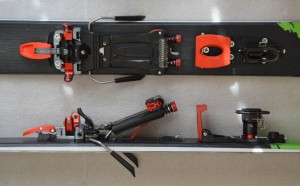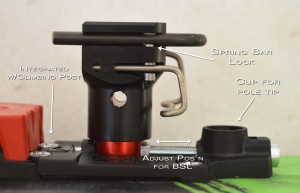The result is a clean, lightweight addition to an already lightweight telemark tech binding, the first to combine a 2-pin tech toe with NTN technology holding the boot at the 2nd heel. As with the classic low-tech binding, there needs to be a gap of approximately 1/4” (5mm) between the back of the boot heel and the front face of the heel unit. In addition to the spring bar moving fore and aft to lock or free the heel, the post the spring-bar is mounted on has some spring travel to it in case the ski flexes enough to cause the heel post to contact the boot, allowing elasticity in the system so it can release if needed.
Parallel performance
The actual release value of the heel unit for Meidjo is quite low, approximately only 1. It is not intended to be used instead of the NTN connection at the duckbutt, but in combination. Thus, there are two release mechanisms working together at the rear of the boot; Meidjo’s heel unit simply adds incremental heel retention for a more alpine feel.

The Full Monty. Free heel tele with a 2-pin tech toe, NTN technology, and an Alpine Touring heel connection (if you want/need it).
As locked heels go, this is perhaps the least retentive locked heel I’ve ever skied. It is solid enough that you can tell the difference between free-heeled parallel turns and those with a locked heel, but even I could tell there was a bit of give to the system. Contrasted with a Marker Kingpin, it was loose. Compared to parallel turns with a free heel, it was solid; solid enough for carving on hardpack with confidence at speed, but not necessarily with confidence when hammering moguls — a practice of dubious value IMO.
Switching Modes
To retract the U-shaped spring-bar, put the tip of your ski pole inside the U, between the U and the back of the heel post, and lever your ski pole back. This causes the tip to depress a wire against the heel post which releases the “lock”, allowing it to move aft. To move the bar forward, put the tip of your ski pole in the plastic cup at the rear of the unit, and with the tip pressing against the back of the U, lever it forward until it snaps in place. Moving just the spring-bar instead of the entire unit is ingenious.
Mounting considerations
Meidjo’s low-tech heel is designed to integrate with the existing heel post by sharing its two rear-most holes. Thus, to mount it all you need to do is connect the low-tech heel to the heel post and match drill two more holes. However, be aware that the post of the low-tech heel can be adjusted for different sized boots. If you plan on sharing your rig with folks who have different sized boots you may want to first adjust the location of the entire heel post and low-tech heel.
As an example, I’m using a size small Meidjo. With the climbing post positioned per the mounting template, the low-tech heel fits my boot in the most forward position of travel. If someone with a smaller boot wanted to try the binding I would have to reposition the climbing post and the low-tech heel further forward and I could then move the low-tech heel post further aft. But this means drilling 5 new holes, not just two, and would put the climbing post awfully close to the springs.
For size large bindings, the adjustment is quite simple. The template will put the climbing post and heel in the correct location for size 26.5 and larger, and the low-tech heel can be easily moved aft for boots with boot sole lengths up to 15mm larger.
Conclusion
You said you wanted the ability to ski locked or free-heeled with the same boot and binding? It is now available. While many telemarkers consider this to be a frivolous option, ski patrollers know they prefer a locked heel in difficult conditions, like when skiing with a toboggan. Plus, as an all mountain skier it is nice to be able to make telemark turns and genuine alpine turns with that extra oomph you get with a locked heel.
The M-Equipment
Meidjo Low-Tech Heel Option
MSRP: TBD
Weight/binding: 4¼ oz. (120 g)
There is one problem with this concept. With Scarpa’s decision to cease offering a tech insert at the heel on their “tech-compatible” NTN boots the list of boots that can take advantage of this feature is shrinking. If you want this option, best to get a pair of use TX boots from before 2015, or this year’s TX-Pro while the heel insert is merely filled with a removeable plug. For 2017, the heel will be solid plastic with no easy way to add the tech heel insert.
© 2016


4 comments
Skip to comment form
Another two holes to drill? Dear Lord!
Look on the bright side – only two more, not four.
Just a quick thing to note
All of Crispi’s ntn line offer tech fittings in toe and heel
What would happen if you’d use a lowvtech back binding that twists away instead of this low tech heel option? Instead of the Meidjo heelpart included in the tele binding you would then use the small heelpart plate to put your boot down on and have the tech part turned away all the time (except from when you want the heel attached) and use the binding’s risers instead of the heel straps. Loose some weight and get a more solid heel solution? But risk nor geting out of the Binding because the boor would be too attached to the skii with toe, heel and the NTN mid-section of the boot?